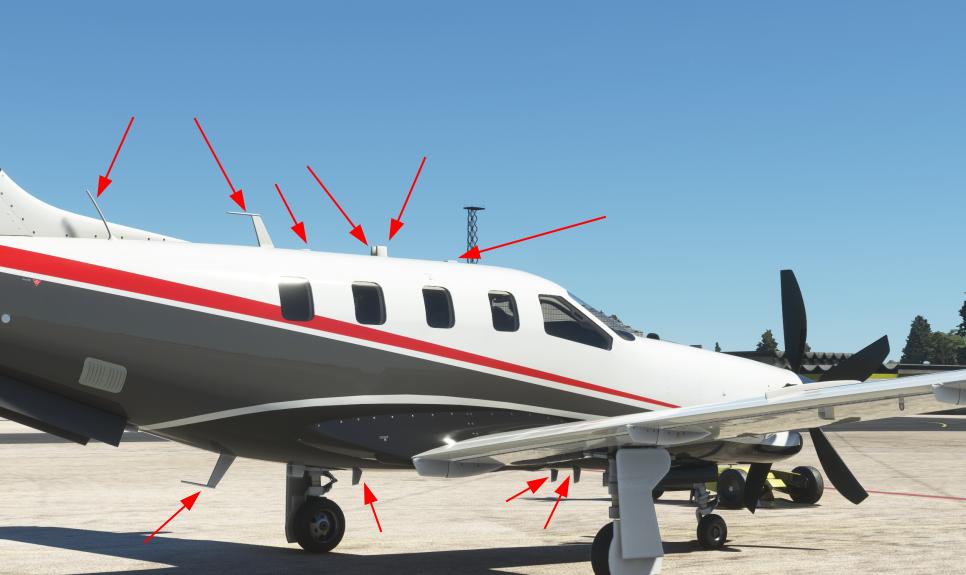
When flying in the simulator, I’m quite amazed how many radios a modern GA airplane or airliner has on board. Sometimes, it feels more like a flying radio tower than an airplane. The picture above and below shows the antennas of a Daher TBM 930 turbo-prop plane on its roof and its underside. Needless to say that all radio systems are not only used in reality, but also in the simulation, particularly when flying on Vatsim. So what are all those antennas for?
Voice Radios
There are so many radios in a sophisticated plane, I’m not sure if I got them all in this article. But let’s try. First, there are of course the voice radios. There are two radios for redundancy purposes, as voice communication with air traffic control and, in special cases when flying VFR to or from uncontrolled airports with other pilots in the area is absolutely essential for safety.
VOR, GS, DME and ILS
And then there are two radios for navigation purposes. In former times, flying to and from VORs (Very high frequency Omni-Range station) was the way to navigate. This has become a bit less relevant in recent years due to GPS navigation. However, the radio navigation receivers are still of the highest importance for ILS (Instrument Landing System) landings, as a ground based transmitter provides lateral guidance during an instrument based landing. In other words, the radio signals tell the pilot how far off to the left or right of the runway he’s currently flying. In addition, a vertical glide slope signal gives the pilot an idea if he’s currently too high or too low on the glide slope towards the runway. And in most cases, an additional Distance Measuring Equipment (DME) radio signal that uses the second radio tells the pilot how far away he is from the runway. All of this is not needed for a visual approach, of course, but planes do not only fly in good weather.
NDBs
Another type of radio transmitter that stems from former times but still used today are non-directonal beacons (NDBs. Like VORs, NDBs can guide a plane towards or from it, but it doesn’t supply directional information, so one can’t use them to fly to or from it on a particular heading. NDBs work on a completely different frequency band from VORs and DMEs, so they probably require their own antenna.
ADS-B
And then there’s Automatic Dependent Surveillance – Broadcast (ADS-B). The transmitter part on an airplane broadcasts the plane’s current position, altitude, it’s registration number, Squawk code, and other parameters. This information is used by air traffic controllers to identify and locate planes. While the classic air traffic radar only shows positions of planes without being able to identify them, ADS-B signals give air traffic controllers a wealth of additional information. ADS-B information is also used on the receiving side of the equipment in a plane for awareness of other planes in the area. Airlines have a Traffic Collision Avoidance System (TCAS) to prevent mid-air collisions in case air traffic control screws up, while smaller planes, such as the TBM 930 use ADS-B data it receives from other planes for the same purpose in its Traffic Advisory System (TAS). ADS-B broadcasts are not encrypted, so they can be picked up by anyone, and services such as Flightradar24 and others make use of this information to show the location of pretty much all planes in many parts of the world in real time. ADS-B also works over the oceans, as the recent generation of Iridium satellites have receivers for it on board. But that’s another story. When having a closer look at Flightradar24 or similar services, it becomes apparent that even many smaller GA airplanes flown by hobbyists have ADS-B transceivers on board, although this is not mandatory. I guess the additional safety is well worth the additional expense to airplane owners.
CPDLC
And finally, there’s a system called Controller Pilot Datalink Communication (CPDLC) system, which is used to communicate with air traffic controllers using text messages while on the ground and also in the air. It helps to reduce the amount of voice communication but is only used in airlines and not in general aviation (GA) planes.
Data Exchange with “The Company”
And then, there’s a radio system for exchanging data such as loadsheets, flightplans, weather and other data with the operation center of the airline, also called “the company” by pilots and air traffic controllers. Directly loading the flight plan and weather information into the flight management computer of the plane significantly reduces the amount of work during pre-flight. I’m not sure if a separate radio is used for this, that remains to be discovered.
Satellites…
Planes do not only fly over places where land based communication is available. Once out of range, satellite communication is frequently used, not only over the oceans but also over land, e.g. for phone calls while in the air. However, let’s talk about satellite communication in a separate episode, as there is quite a bit to be told about this as well.